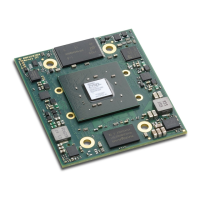1 Overview
1.1 General
1.1.1 Introduction
The Mercury ZX1 SoC module combines the Xilinx Zynq®-7030/7035/7045 All Programmable SoC (System-
on-Chip) device with USB 2.0 On-The-Go PHY, PCIe® Gen2 ×4/×8, Gigabit Ethernet PHY, dual Fast Ethernet
PHY, two fast DDR3 SDRAM memory channels, NAND flash, multi-gigabit transceivers, high-speed LVDS I/O,
and a real-time clock, forming a complete and powerful embedded processing system.
The use of the Mercury ZX1 SoC module, in contrast to building a custom SoC hardware, significantly re-
duces development effort and redesign risk and improves time-to-market for the embedded system.
Together with Mercury base boards, the Mercury ZX1 SoC module allows the user to quickly build a system
prototype and start with application development.
The Enclustra Build Environment [14] is available for the Mercury ZX1 SoC module. This build system allows
the user to quickly set up and run Linux on any Enclustra SoC module. It allows the user to choose the
desired target and download all the required binaries, such as bitstream and FSBL (First Stage Boot Loader).
It downloads and compiles all required software, such as U-Boot, Linux, and BusyBox based root file system.
1.1.2 Warranty
Please refer to the General Business Conditions, available on the Enclustra website [1].
1.1.3 RoHS
The Mercury ZX1 SoC module is designed and produced according to the Restriction of Hazardous Sub-
stances (RoHS) Directive (2011/65/EC).
1.1.4 Disposal and WEEE
The Mercury ZX1 SoC module must be properly disposed of at the end of its life.
The Waste Electrical and Electronic Equipment (WEEE) Directive (2002/96/EC) is not applicable for the Mer-
cury ZX1 SoC module.
1.1.5 Safety Recommendations and Warnings
Mercury modules are not designed to be “ready for operation” for the end-user. These can only be used in
combination with suitable base boards. Proper configuration of the hardware before usage is required.
Ensure that the power supply is disconnected from the board before inserting or removing the Mercury ZX1
SoC module, connecting interfaces, replacing batteries, or connecting jumpers.
Touching the capacitors of the DC-DC converters can lead to voltage peaks and permanent damage; over-
voltage on power or signal lines can also cause permanent damage to the module.
D-0000-403-002 6 / 56 Version 05, 25.07.2019

